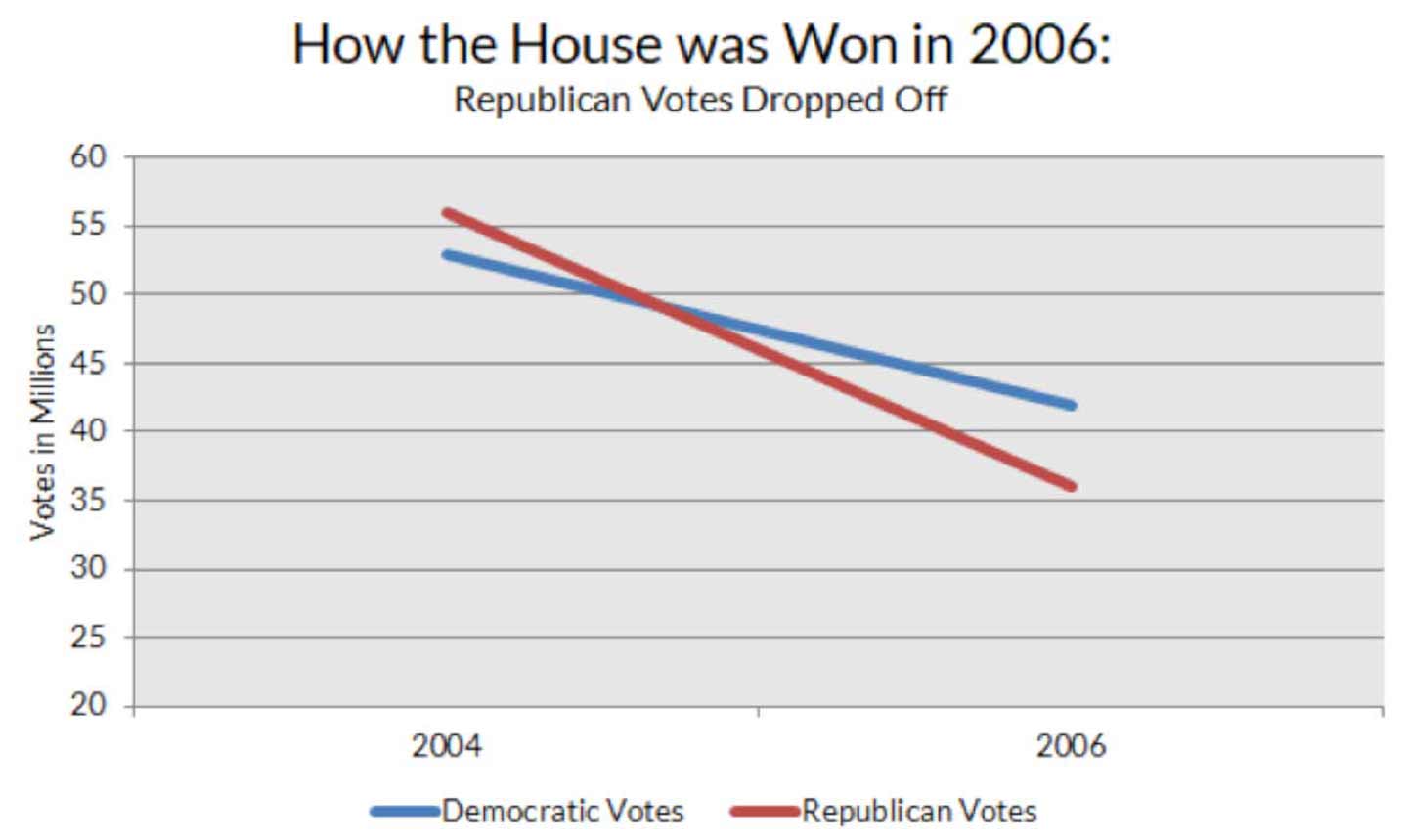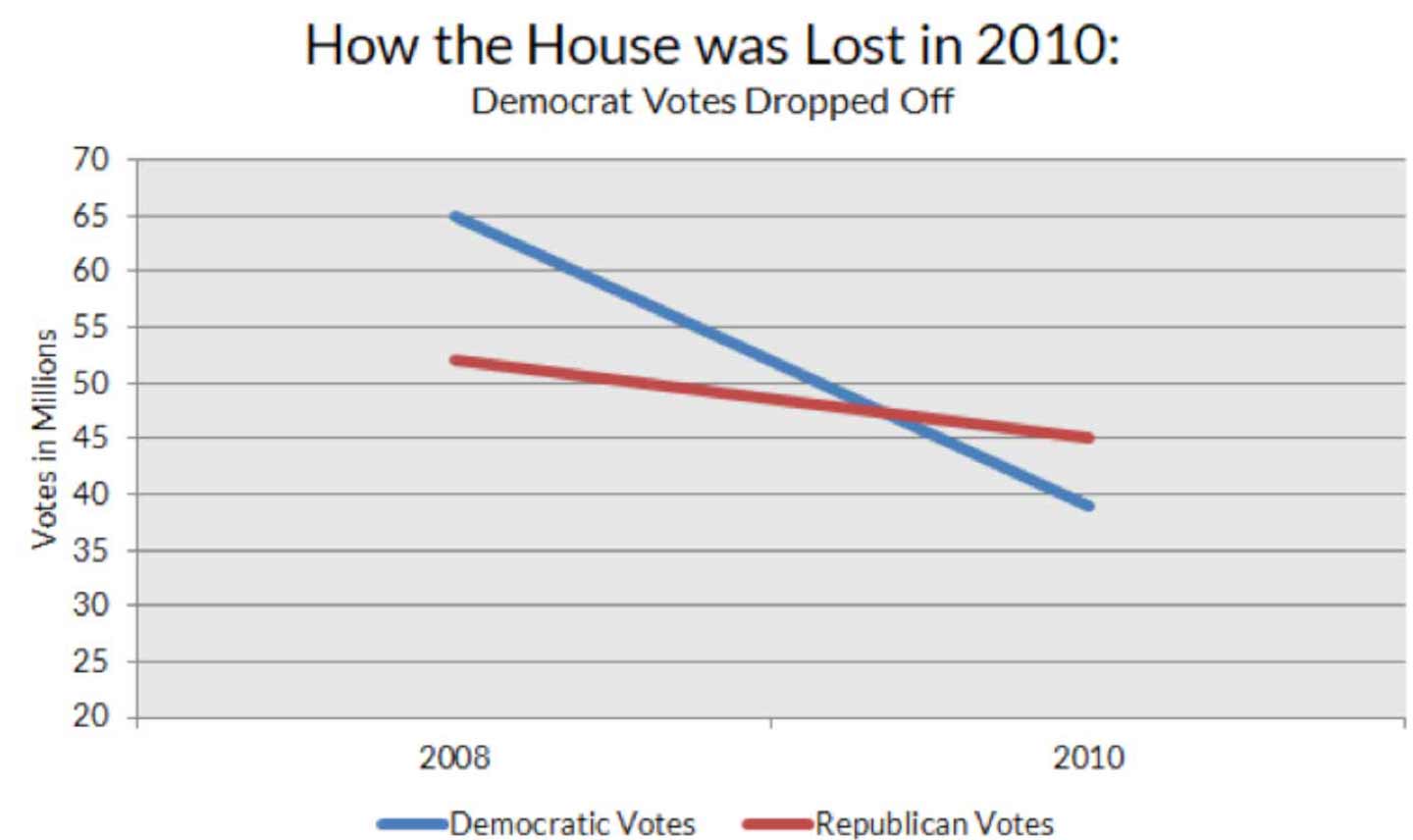Many people believe that the outcome of midterm elections depends on the ideological profile of the candidates who are running. Moderate candidates appeal to swing voters who might be rethinking their presidential vote, conventional wisdom goes. But the outcome of non-presidential year elections depends in large part on voter turnout. And this reality, combined with a new report from the Voter Participation Center and Lake Research, amounts to a bright, flashing warning sign for Democrats heading into the 2018 election cycle. Absent significant course corrections by progressives, the turnout of people of color and progressive whites is likely to fall dangerously low next year, scuttling the golden opportunity to recapture control of the body that can impeach a president.
Analyzing Census and election data, the VPC/Lake report concludes that, based on those past trends, the turnout of people of color, white millennials, and white unmarried women—cornerstones of the Obama coalition—will fall by 35 percent from 2016 levels, accounting for 25.4 million fewer voters from those critical constituencies. For African Americans, the rate is projected to drop 30 percent. For Latinos, the report estimates a decline of 36.5 percent, and for millennials the drop off is pegged at a dismaying 54 percent.
These numbers should set off ear-piercing alarm bells for every person who wants to win back the House. Unfortunately, such findings frequently fall on deaf ears. A significant number of people in the leadership of Democratic and progressive politics hold the belief that the best way for Democrats to prevail in off-year elections is by moderating their politics to appeal to swing voters who may be turned off by the excesses and overreach of the party in power. According to this interpretation, Democrats won the House in 2006 because the Democratic Congressional Campaign Committee under Rahm Emanuel’s leadership recruited moderate candidates who attracted support from swing voters recoiling from the policies of George W. Bush’s administration. A decade later, this narrative is regularly repeated in the media, with Politico reporting just this past May that “Three senior House Democrats are soon heading to Chicago to seek advice from Rahm Emanuel, the party’s 2006 master strategist.” Emanuel’s magic formula? Focus on “the suburbs, where more moderate voters exist…I purposely recruited candidates who reflected the temperament, tenor and culture of their district.”
The same interpretation leads to the conclusion that the reason Republicans took back the House in 2010 is because of a backlash from voters angry about the passage of the Affordable Health Care Act. David Axelrod, Obama’s senior adviser at the time, wrote in his book, Believer, that Obama’s efforts to pass health-care reform “ignited a blazing grassroots opposition that would cost him his House majority.”
The persistence and power of that narrative continues to shape progressive and Democratic strategy to this day. When current DCCC Chairman Ben Ray Luján was asked recently whether the party would only back candidates who were fully committed to defending women’s reproductive freedom, Luján hemmed and hawed and ultimately echoed the Emanuel mindset, saying, “There is not a litmus test for Democratic candidates” because “you need to make sure you have candidates that fit the district, that can win in these districts.”
Popular
"swipe left below to view more authors"Swipe →But, setting aside the more existential question of what the point of having a political party even is if it won’t fight for its constituents, looking at math, rather than myths, suggests another story. In 2006, the number of Republican votes fell sharply, dropping by 36 percent, while the number of Democratic votes fell just 20 percent. The tables turned in 2010, when 26 million Democratic votes dropped off, while Republican votes declined by just 7 million votes. The following charts illustrate just how control of the House switched parties in 2006 and 2010.
Drilling down deeper into the 31 seats that flipped the House in 2006, one sees that mobilization was a key factor. In all but a handful of the seats Democrats won in 2006, there was dramatic drop-off in Republican votes and significantly better Democratic vote performance. In 2006, Democrats needed to flip 15 seats to gain control of the House, and they won 31 previously Republican-held districts. In 21 of those districts, the number of Republican votes fell so low that Democrats didn’t need to convert any swing voters to win the seats. Although in some districts it is likely that they did pick up some people who had voted Republican two years prior, the point is they didn’t have to because they had enough votes as long as they reenergized their core Democratic voters.
If turnout is the key—and it is—then the VPC/Lake study should cause progressives to panic about their prospects in 2018. Instead, Democrats display an inexplicable incongruity between what the problem actually is and what their proposed solutions are. We see studies and articles and special initiatives targeting white working-class voters, but nothing—literally nothing—focused on understanding, engaging, and mobilizing people of color and progressive whites (including the progressive wing of the white working class). Where is the national conference, the high-level task force, and, most importantly, the multimillion-dollar budget focused on addressing the most important key to winning back the House—preventing drop-off among core Democratic voters?
The national party’s messaging and slogans, candidate recruitment, and political spending should be focused like a laser on identifying, communicating with, and inspiring those people who opposed Trump in 2016 to come back out and vote against Trump’s party in 2018. Every dime and day spent trying to show Trump voters the error of their ways is a lost opportunity to apply the lessons of how to win midterm elections. Turnout wins midterms. Everything else is a waste of time, energy, resources, and breath.




